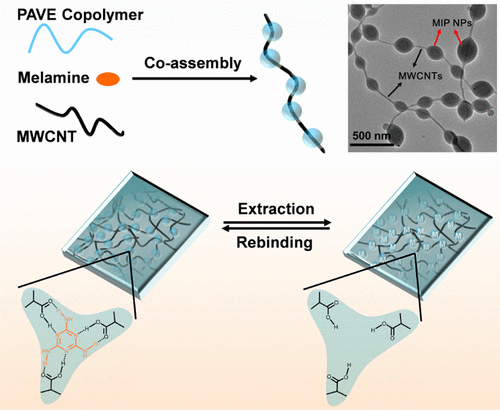当前位置:
X-MOL 学术
›
ACS Appl. Mater. Interfaces
›
论文详情
Our official English website, www.x-mol.net, welcomes your feedback! (Note: you will need to create a separate account there.)
Necklace-like Molecularly Imprinted Nanohybrids Based on Polymeric Nanoparticles Decorated Multiwalled Carbon Nanotubes for Highly Sensitive and Selective Melamine Detection
ACS Applied Materials & Interfaces ( IF 9.5 ) Pub Date : 2018-07-05 00:00:00 , DOI: 10.1021/acsami.8b08558 Sheng Xu 1 , Geyu Lin 1 , Wei Zhao 1 , Qian Wu 1 , Jing Luo 1 , Wei Wei 1 , Xiaoya Liu 1 , Ye Zhu 1
ACS Applied Materials & Interfaces ( IF 9.5 ) Pub Date : 2018-07-05 00:00:00 , DOI: 10.1021/acsami.8b08558 Sheng Xu 1 , Geyu Lin 1 , Wei Zhao 1 , Qian Wu 1 , Jing Luo 1 , Wei Wei 1 , Xiaoya Liu 1 , Ye Zhu 1
Affiliation

|
In this study, molecularly imprinted nanohybrids with “necklace-like” nanostructures were developed based on self-assembled polymeric nanoparticles decorated multiwalled carbon nanotubes (MWCNTs) by employing melamine as template molecules. An amphiphilic copolymer poly(acrylic acid-co-(7-(4-vinylbenzyloxy)-4-methyl coumarin)-co-ethylhexyl acrylate) (poly(AA-co-VMc-co-EHA), PAVE) containing photosensitive coumarin units was synthesized first. Then, the PAVE copolymers were co-assembled with MWCNTs in the presence of template molecules, generating photosensitive molecularly imprinted nanohybrids (MIP-MWCNTs) with necklace-like structures. Subsequently, the MIP-MWCNTs nanohybrids were used to modify electrode surface followed by photo-polymerization of the coumarin units in the nanohybrids, leading to a network architectured complex film. After extracting melamine molecules by electrolysis, a melamine MIP sensor was successfully developed. The as-prepared sensor exhibited a significantly wide linear range (1.0 × 10–12–1.0 × 10–6 mol L–1) and a low detection limit (5.6 × 10–13 mol L–1) for melamine detection. High selectivity of the sensor toward melamine was well demonstrated with respect to other melamine analogues and interferents. Furthermore, the MIP sensor showed high stability and reproducibility. The excellent performance of the MIP sensor can be attributed to the unique nanostructure of the complex film provided by these necklace-like nanohybrids. On the one hand, the nanosized polymeric MIP nanoparticles along the MWCNTs increase the effective electrode surface area and thus offer a high melamine-binding capacity. On the other hand, the MWCNTs in MIP-MWCNTs nanohybrids serve as “electronic bridges” to accelerate the electron transfer among the complex MIP film. More importantly, the MIP sensor was practically used to monitor melamine in milk samples, demonstrating a promising feature for applications in the analysis of food like milk and other food products including milk powder, infant formula, and animal feed. Considering the ease of polymeric nanoparticles functionalization, the necklace-like nanohybrids would be extended to wider applications in many other sensors and devices.
中文翻译:

基于聚合物纳米粒子的项链状分子印迹纳米杂物修饰的多壁碳纳米管,用于高灵敏度和选择性的三聚氰胺检测
在这项研究中,以三聚氰胺为模板分子,基于自组装的聚合物纳米颗粒装饰的多壁碳纳米管(MWCNT),开发了具有“项链状”纳米结构的分子印迹纳米杂化物。两亲共聚物聚(丙烯酸-共-(7-(4-乙烯基苄氧基)-4-甲基香豆素)-共-丙烯酸乙基己酯)(聚(AA-共-VMc- co首先合成了含有感光香豆素单元的-EHA),PAVE)。然后,在模板分子存在下,将PAVE共聚物与MWCNT共组装,生成具有项链状结构的光敏分子印迹纳米杂化物(MIP-MWCNT)。随后,将MIP-MWCNTs纳米杂化物用于修饰电极表面,然后对纳米杂物中的香豆素单元进行光聚合,从而形成网络结构的复合膜。通过电解提取三聚氰胺分子后,成功开发了三聚氰胺MIP传感器。所准备的传感器具有很大的线性范围(1.0×10 –12 –1.0×10 –6 mol L –1)和较低的检测极限(5.6×10 –13 mol L –1))用于检测三聚氰胺。相对于其他三聚氰胺类似物和干扰物,传感器对三聚氰胺的高选择性已得到充分证明。此外,MIP传感器显示出高稳定性和可重复性。MIP传感器的出色性能可以归因于这些项链状纳米杂化物提供的复合膜独特的纳米结构。一方面,沿着MWCNT的纳米级聚合物MIP纳米颗粒增加了有效电极表面积,并因此提供了高的三聚氰胺结合能力。另一方面,MIP-MWCNTs纳米杂化物中的MWCNT充当“电子桥”,以加速复杂MIP膜之间的电子转移。更重要的是,MIP传感器实际上用于监测牛奶样品中的三聚氰胺,证明了在分析食品(如牛奶和其他食品,包括奶粉,婴儿配方食品和动物饲料)中的应用前景广阔。考虑到聚合物纳米颗粒功能化的难易程度,项链状纳米杂化物将扩展到许多其他传感器和设备中的更广泛应用。
更新日期:2018-07-05
中文翻译:

基于聚合物纳米粒子的项链状分子印迹纳米杂物修饰的多壁碳纳米管,用于高灵敏度和选择性的三聚氰胺检测
在这项研究中,以三聚氰胺为模板分子,基于自组装的聚合物纳米颗粒装饰的多壁碳纳米管(MWCNT),开发了具有“项链状”纳米结构的分子印迹纳米杂化物。两亲共聚物聚(丙烯酸-共-(7-(4-乙烯基苄氧基)-4-甲基香豆素)-共-丙烯酸乙基己酯)(聚(AA-共-VMc- co首先合成了含有感光香豆素单元的-EHA),PAVE)。然后,在模板分子存在下,将PAVE共聚物与MWCNT共组装,生成具有项链状结构的光敏分子印迹纳米杂化物(MIP-MWCNT)。随后,将MIP-MWCNTs纳米杂化物用于修饰电极表面,然后对纳米杂物中的香豆素单元进行光聚合,从而形成网络结构的复合膜。通过电解提取三聚氰胺分子后,成功开发了三聚氰胺MIP传感器。所准备的传感器具有很大的线性范围(1.0×10 –12 –1.0×10 –6 mol L –1)和较低的检测极限(5.6×10 –13 mol L –1))用于检测三聚氰胺。相对于其他三聚氰胺类似物和干扰物,传感器对三聚氰胺的高选择性已得到充分证明。此外,MIP传感器显示出高稳定性和可重复性。MIP传感器的出色性能可以归因于这些项链状纳米杂化物提供的复合膜独特的纳米结构。一方面,沿着MWCNT的纳米级聚合物MIP纳米颗粒增加了有效电极表面积,并因此提供了高的三聚氰胺结合能力。另一方面,MIP-MWCNTs纳米杂化物中的MWCNT充当“电子桥”,以加速复杂MIP膜之间的电子转移。更重要的是,MIP传感器实际上用于监测牛奶样品中的三聚氰胺,证明了在分析食品(如牛奶和其他食品,包括奶粉,婴儿配方食品和动物饲料)中的应用前景广阔。考虑到聚合物纳米颗粒功能化的难易程度,项链状纳米杂化物将扩展到许多其他传感器和设备中的更广泛应用。


























 京公网安备 11010802027423号
京公网安备 11010802027423号